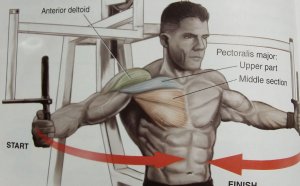
Health Style Fitness
(The following article is excerpted from the book, The Power Of Champions, available world wide through top fitness professions.)
Many people seeking a positive health and fitness change are very confused about the differences between simple and complex carbohydrates. And to make matters worse, many of the popular weight-loss solutions seem to do all they can to cloud the waters even further. My goal here is to help you understand the difference between the simple and complex carbohydrates, show you how they impact your health and fitness, and provide you with some simple steps you can take – today – to move you closer to becoming your own fitness champion. After reading this information, you will be one critical step closer toward reaching your absolute physical best!
Carbohydrates are one of three necessary macronutrients that provide calories in our diets. The other two are protein and fat. Carbohydrates provide most of the energy needed in our daily lives, both for normal body functions (such as heartbeat, breathing, digestion, and brain activity) and for exercise (like biking, walking, running up the stairs and all types of resistance training). An ample supply of carbohydrates is absolutely necessary to sustain a healthy existence and a must if your goal is to reduce your body fat and enhance your fitness level.
Carbohydrates are considered simple or complex based upon their chemical structure. Both types contain four calories per gram, and both are digested into the bloodstream as glucose, which is then used to fuel our bodies for normal daily activity and exercise. The main difference between simple and complex carbs is:
Simple carbohydrates or simple sugars - These carbs are broken down and digested very quickly, but most simple carbs contain refined sugars and very few essential vitamins and minerals. Examples include table sugar, fruit juice, milk, yogurt, honey, molasses, maple syrup and brown sugar.
Complex carbohydrates - the complex carbs take longer to digest and are packed with fiber, vitamins and minerals. Examples include vegetables, whole grain breads, oatmeal, legumes, brown rice and wheat pasta.
When you eat (or drink) a simple carbohydrate or a simple sugar – whether it is a can of soda, a scoop of fat-free ice cream, or even a glass of orange juice – all of the ingested sugar quickly rushes into your bloodstream. You typically feel a quick rush of energy. Your body then promptly reacts to this sudden spike in blood sugar by calling on the pancreas to produce additional insulin to remove the excess sugar from your blood. And for the moment, you have significantly lower blood sugar as a result of the insulin doing its job, resulting in a sense or feeling of needing more fuel, more energy and more calories. And as you hit that residual low blood sugar, you begin to crave more of the quick-release, simple sugars, and hence you have just initiated the sugar craving cycle.
As this downward cycle continues, your pancreas continues to secrete insulin while it simultaneously reduces its production of another hormone called glucagon. Glucagon production, as it relates to improving your body composition, is very important if your fitness goal is to lose excess body fat. Glucagon is the only hormone that allows stored body fat to be released into the bloodstream to be burned by your muscles as energy. And when the pancreas has to elevate its production of insulin while reducing its supply of glucagon, you are basically locking-in your excess body fat. Therefore, too much simple sugar intake dramatically hinders the process of reducing stored body fat.
American’s consumption of sugar continues to rise year after year. So too, does obesity in our country. In my opinion, the correlation between increased sugar consumption and obesity is telling. When 16-20 percent of daily calorie intake is coming from sugar, Americans are not only locking in stored body fat, but also squeezing out the healthier, more supportive and nutrient-dense food choices. Sugar is the enemy of body fat reduction; and the enemy of a healthy, high energy lifestyle. So, do your best to begin to understand what’s in the food you are consuming and reduce those that contain more than a few grams of sugar.
When searching out the food choices that include simple carbs (i.e., sugars), start by looking for obvious ingredients on food labels that actually use the word “sugar”, like brown sugar, sugar cane, and of course, just simple sugar. Also, reduce your intake of foods that have any form of “syrup” in their ingredients. For example, corn syrup, high-fructose corn syrup, maple syrup and glucose syrup. And finally, look for those ingredients that end in “–ose”, like sucrose, glucose, lactose and fructose. All of these ingredients are sugars and, if ingested, will spike your blood sugar and initiate the pancreas to produce insulin and essentially shut off glucagon production – the fat release hormone.
INTERESTING VIDEO



Share this Post
Related posts
Chest Workout for definition
Has never been complex, he always focused on the basics. So if you want to get a big chest, we prepared you a workout inspired…
Read MoreGym Regimen
You ve decided it s time to start exercising. Congratulations! You ve taken the first step on your way to a new and improved…
Read More









